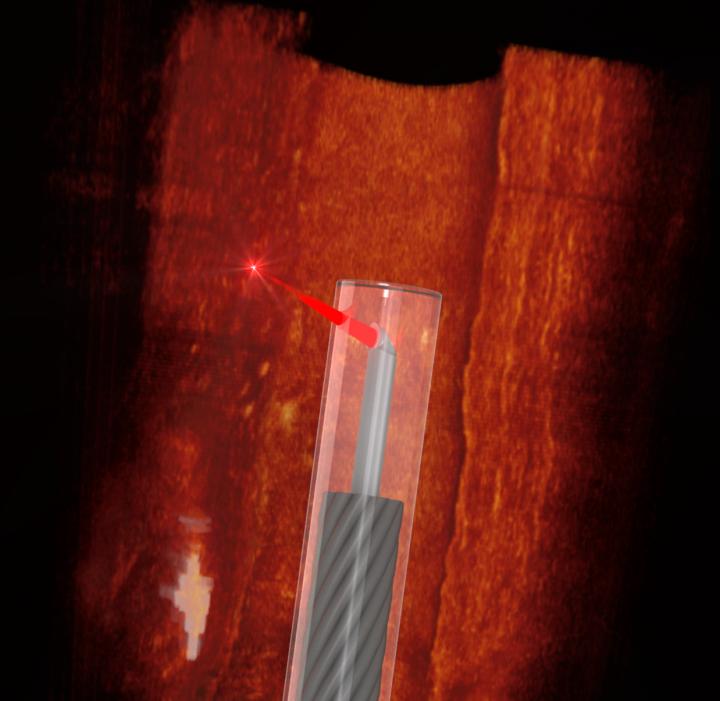World's smallest imaging device has heart disease in focus

Ultrathin 3D printed endoscope imaging an artery. Image by Simon Thiele and Jiawen Li
The camera-like imaging device can be inserted into blood vessels to provide high quality 3D images to help scientists better understand the causes of heart attack and heart disease progression, and could lead to improved treatment and prevention.
In a study published in the journal Light: Science & Applications, a multidisciplinary team of researchers and clinicians was able to 3D print a tiny lens on to the end of an optical fibre, the thickness of a human hair.
The imaging device is so small that researchers were able to scan inside the blood vessels of mice.
Dr Jiawen Li, co-author and Heart Foundation Postdoctoral Fellow at the Institute for Photonics and Advanced Sensing, University of Adelaide, says in Australia cardiovascular disease kills one person every 19 minutes.
“A major factor in heart disease is the plaques, made up of fats, cholesterol and other substances that build up in the vessel walls,” Dr Li said.
“Preclinical and clinical diagnostics increasingly rely on visualising the structure of the blood vessels to better understand the disease.
“Miniaturised endoscopes, which act like tiny cameras, allow doctors to see how these plaques form and explore new ways to treat them,” she said.
Dr Simon Thiele, Group Leader, Optical Design and Simulation at the University of Stuttgart, was responsible for fabricating the tiny lens.
“Until now, we couldn't make high quality endoscopes this small,” Dr Thiele said.
“Using 3D micro-printing, we are able to print complicated lenses that are too small to see with the naked eye.
“The entire endoscope, with a protective plastic casing, is less than half a millimetre across,” he said.
Dr Li explains: “It's exciting to work on a project where we take these innovations and build them into something so useful.
“It's amazing what we can do when we put engineers and medical clinicians together,” said Dr Li.
###
The research collaboration also included researchers from The South Australian Health and Medical Research Institute, The Royal Adelaide Hospital and Monash University.
Media Contact
All latest news from the category: Medical Engineering
The development of medical equipment, products and technical procedures is characterized by high research and development costs in a variety of fields related to the study of human medicine.
innovations-report provides informative and stimulating reports and articles on topics ranging from imaging processes, cell and tissue techniques, optical techniques, implants, orthopedic aids, clinical and medical office equipment, dialysis systems and x-ray/radiation monitoring devices to endoscopy, ultrasound, surgical techniques, and dental materials.
Newest articles

First-of-its-kind study uses remote sensing to monitor plastic debris in rivers and lakes
Remote sensing creates a cost-effective solution to monitoring plastic pollution. A first-of-its-kind study from researchers at the University of Minnesota Twin Cities shows how remote sensing can help monitor and…

Laser-based artificial neuron mimics nerve cell functions at lightning speed
With a processing speed a billion times faster than nature, chip-based laser neuron could help advance AI tasks such as pattern recognition and sequence prediction. Researchers have developed a laser-based…

Optimising the processing of plastic waste
Just one look in the yellow bin reveals a colourful jumble of different types of plastic. However, the purer and more uniform plastic waste is, the easier it is to…



